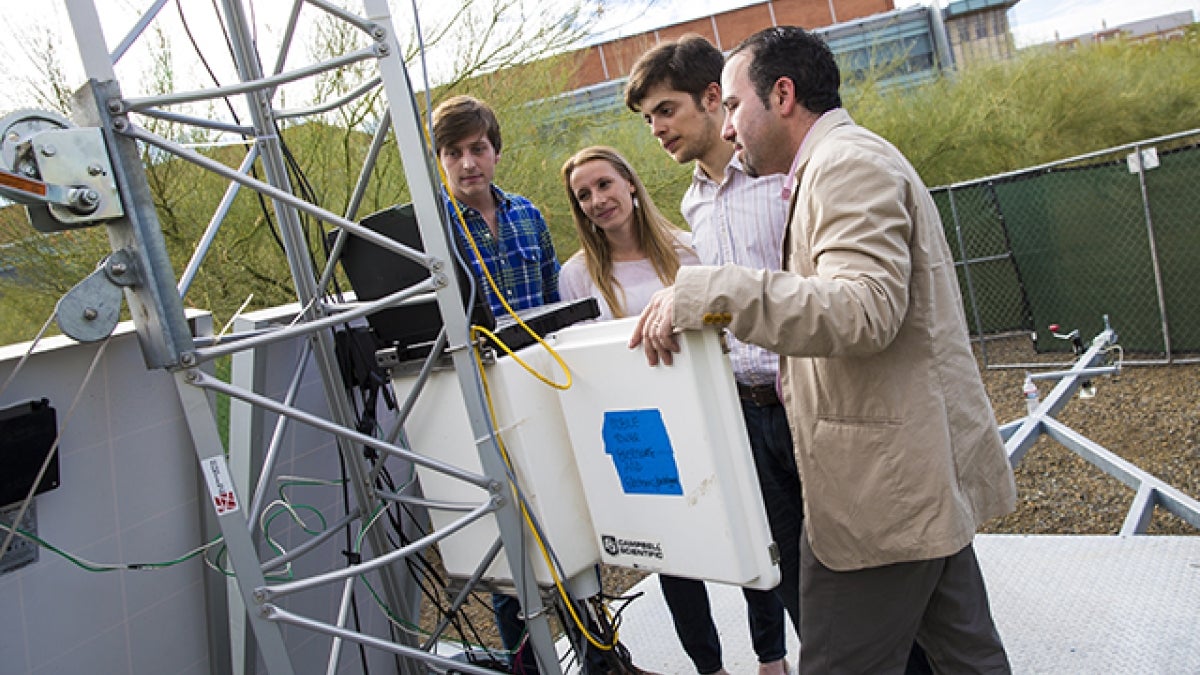Students strive for deeper understanding of urban desert meteorology

A meteorological flux tower assembled by three ASU students is being deployed at various campus sites to study factors that impact urban desert climates. Checking out sensing devices on the tower are students (from left) Adam Schreiner-McGraw, Nicole Pierini and Ivan Lopez-Castrillo and professor Enrique Vivoni.
Photo by: Jessica Hochreiter/ASU
Three Arizona State University engineering and science students are hoping to contribute to knowledge of the complex interplay of energy and water fluxes in our built urban environments.
With the support of a grant from the Earth Materials and Processes program of the U.S. Army Research Office, they have deployed a 30-foot metal tower equipped with environmental and meteorological sensors in an irrigated grassy area at ASU’s Polytechnic campus in Mesa.
The sensing devices mounted on the meteorological flux tower track changes in moisture, carbon dioxide, energy and wind speed and direction, among other things.
The tower had been set up on the Tempe campus this spring – first in a sparsely vegetated desert area near the Biodesign Institute building, and then in an asphalt-paved parking lot near a high-traffic intersection.
The project team is comparing how energy and water fluctuations change as the land cover varies from engineered surfaces to irrigated landscaping at the three Tempe and Polytechnic campus settings. The aim is to better understand the interactions of engineered surfaces, soils and vegetation with the surrounding atmosphere, and how they affect evaporation, gas and heat-transfer processes.
What they find could reveal important information about fluxes in energy and moisture levels in urban environments, says team member Nicole Pierini, a doctoral student in the hydrosystems engineering program.
She’s working with civil engineering undergraduate Ivan Lopez-Castrillo and geological sciences doctoral student Adam Schreiner-McGraw, under the direction of Enrique Vivoni, a professor in the School of Sustainable Engineering and the Built Environment, and the School of Earth and Space Exploration.
By putting the flux tower in a greenbelt setting at the Polytechnic campus site during the summer, the students have been able to measure environmental interactions during Arizona’s monsoon.
“We’ll be able to see the relationship between the energy fluxes and varying moisture input in very different weather conditions than at other times of the year,” Pierini says. “We hope this will give us insight into how regularly irrigated grass plays a role in evapotranspiration rates within an urban environment.”
After mid-August, the team began comparing data from the three sites to identify what locations promote heat emissions that cause the urban heat-island effect, and to quantify the effect of irrigation on ameliorating or altering these heat emissions at each site. The role of irrigation can also be compared to the landscape’s natural responses to rain events during the spring and summer seasons.
“The deployment of this new mobile tower in the three different urban-cover types has really opened our eyes to the large differences in energy and water fluxes within the built environment,” Vivoni says. “We have also been lucky to have been monitoring the sites during unusually wet periods in the spring and early summer, as well as during our monsoon season. The results should be very telling about how the surface energy budget varies within our desert urban region.”
Team members say more extensive research data from such studies could help regions cope more effectively with the implications of changes in urban climate – including changes in air quality, energy and water conditions and greenhouse gas emissions.
The Army Research Office is interested in the research because of its potential to increase understanding of the impacts of climate conditions in the types of desert environments in which the nation’s military could be called on to carry out more operations in the future.
The project is giving the students valuable experience in seeking out collaborators whose assistance and expertise is necessary for carrying out their work, Pierini says.
Help in obtaining permission to set up the tower, finding appropriate locations for the structure and providing irrigation data has come from Raymond Humbert, associate director of operations for ASU Parking and Transit Services, and from Polytechnic campus facilities management director John Herrera and grounds supervisor Jimmy Mastalsz.